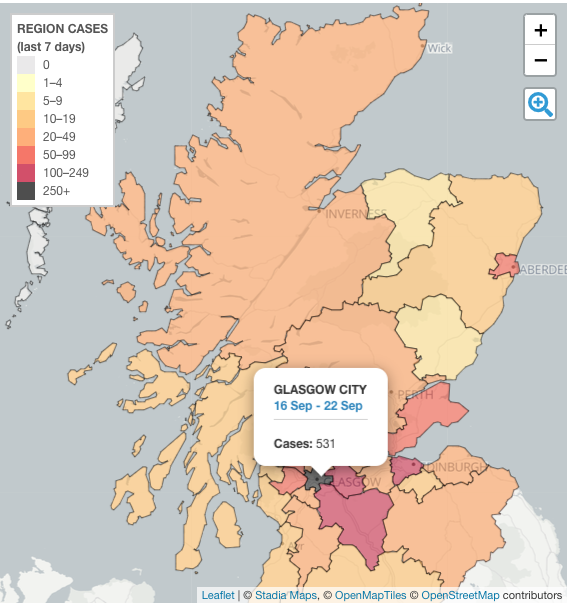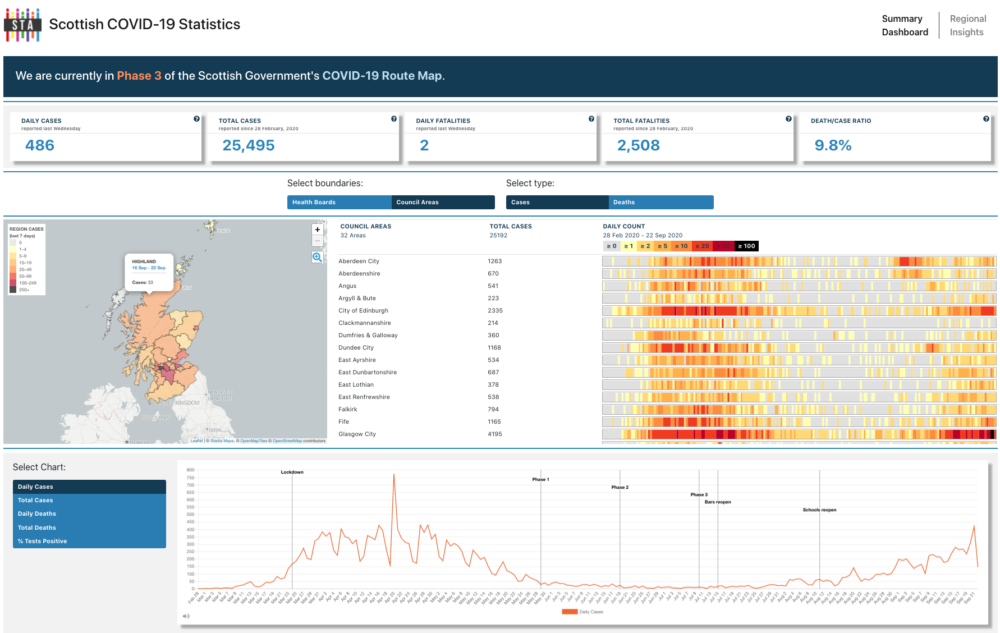The tech army drawn together by entrepreneurs Alistair Forbes and Peter Jaco earlier this year will achieve a world first with its sonification project.
This is a way for people with visual impairment to access Covid-19 data which is converted from visual data to a series of notes of various pitches. These will produce auditory graphs so that the user can ‘hear’ them.
This is a new element in the publicly accessible dashboard presenting the country’s most up to date information on the coronavirus. Users will be able to track their local area and perhaps understand the local situation better. The hope is that by doing so individuals will make informed decisions about their behaviour personally and in business, although all in line with government advice.

The dashboard updates daily using data made available by The Scottish Government and the NHS under their open data initiatives. It is compatible with screen readers, and incorporates high resolution colour contrast, heat maps and key graphs to track and display infection rates.
The dashboard developed out of a challenge set by Scotland’s Tech Army (STA) organisers. Volunteers were asked to take the open source COVID-19 data provided by the Scottish Government and develop a way of presenting it that would be easier for the people to use and understand.

Eirini Kominou, an STA volunteer, helped integrate data sonification into the dashboard. Eirini recently completed her PhD in machine learning and data at the University of Strathclyde and is visually impaired, so she knows how valuable this tool will be for those with accessibility needs.
She said: “Most scientific data sets are communicated with the support of visual representations such as graphs. This poses significant problems for many people who cannot easily read data in this format. Sonification has seen some early use in fields like astronomy and geoscience to present and analyse complex data sets. However, using it in the dashboard will bring the technique to the wider public for the first time.
“We hope the dashboard will be widely used in Scotland to help individuals to more easily interpret the wealth of statistics and data currently circulating. Due to its regional focus and up-to-date data, we believe this tool will allow individuals to make informed decision based on the specific situation in their local area. However, as the field of data science develops, it is important that we are actively assessing and continually evolving how best to present findings, in line with accessibility needs.”

Scotland’s Tech Army connects all of those tech professionals in Scotland with projects harnessing digital innovation to help create solutions to the pandemic and support the recovery from it.
Co-founder, Alistair Forbes, said: “When we set up the Scottish Tech Army at the beginning of lockdown, it was with the aim of mobilising the exceptional talent within our technology sector to tackle emerging issues related to COVID-19.
“However, we also have a particular focus on giving new and emerging talent an opportunity to gain hands-on experience when delivering solutions. The dashboard challenge has taken our volunteers through a full project lifecycle, equipping them with professional know-how to complement their existing technical skills.
“When we set the volunteers the challenge of making the Scottish COVID-19 data more accessible, we knew they would come up with excellent ideas to help users visualise the information. However, they have gone even further by assessing and meeting the needs of visually impaired users.
“Globally, this is something that no-one else is prioritising when communicating the science on COVID-19. Our team is breaking new ground and, importantly, establishing a precedent for how we address accessibility in data science moving forward.”

Source: The Edinburgh Reporter

